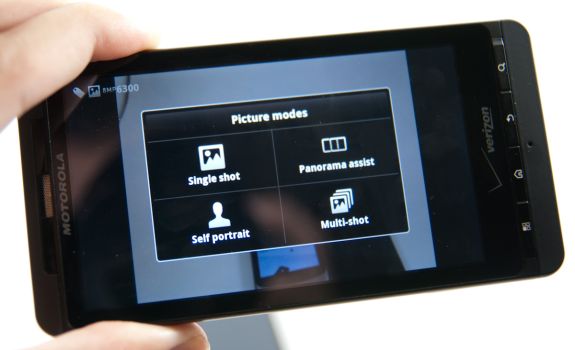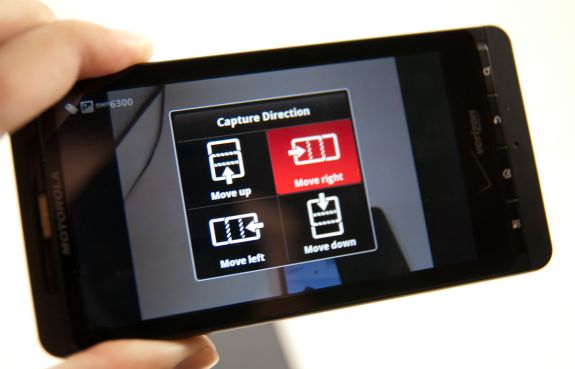Motorola Droid X: Thoroughly Reviewed
by Brian Klug on July 20, 2010 4:27 PM EST- Posted in
- Smartphones
- Motorola Droid X
- OMAP
- Mobile
Still Captures
What’s particularly interesting about the X is that it contains a bonafide mechanical shutter system that actually actuates. It doesn’t happen all the time, but it’s there. In what testing I’ve done, the shutter actually seems to activate of the time in low light situations than in bright light outdoors, which is a bit paradoxical to me. If you look close in the video, you can actually see the lens assembly go in and out for focusing, which is pretty normal.
Stills themselves aren’t amazing on the Droid X, but a definite step up from the camera on the Motorola Droid. If you’re making that jump, the difference will be a welcome improvement in camera quality.
You can compare all of the shots we’ve taken at 7 different locations in the gallery below. I’ve updated the results with an example shot from a Nikon D80 DSLR as well for comparison as something of a baseline. We’ve now got photos from the Droid X, EVO 4G, HTC Incredible, iPhone 3GS, iPhone 4, KIN ONE, KIN TWO (which has the competing 8 megapixel Sony IMX046 SoC), Motorola Droid, N900, and Nexus One. Location 7 and 4 are the most interesting, in my estimation.
The shots really speak for themselves. The EVO 4G and Incredible tend to oversaturate and over-sharpen, and the iPhone 4 does have some over-saturation of its own.
What I found particularly interesting about the X’s shooting modes for stills was in picture modes. The X will let you shoot stills very quickly at the expense of quality - they’re captured at 1 megapixel - in multi-shot mode. You don’t get to dictate when the exposures take place, 6 photos are just captured in rapid succession.
Next, there’s a self portrait mode that uses face detection to take your photo whenever it sees a face. Remember face detection I hit on earlier? This is an interesting application for it. Unfortunately, it refuses to detect my face and take the photo about 80% of the time. I even used my notebook’s built in webcam to monitor what was going on and if my face was in the frame. Even perfectly centered, most of the time inexplicably no dice. It even pops up a “no faces detected” box after 30 seconds. Apparently I’m a vampire or somesuch living undead.
But what I found really intriguing was the included auto stitch panorama mode. This is one of the most interesting applications I’ve seen for the compass; location aware image stitching. That’s right, you go into this mode, and can stitch together six images. That’s been done before, sure, but in the bottom left, you get an augmented reality preview showing how far you need to rotate to the next position before a photo is automatically captured. Repeat the process, and the software stitches the images back together automatically.
There’s just something so right about this process - I shouldn’t have to manually overlay bits of the previous image if the smartphone already has a good enough compass to know what direction we’re pointed, so do it in software! The X does precisely that.



















89 Comments
View All Comments
TareX - Thursday, July 22, 2010 - link
Why are all the Samsung Galaxy S phones missing from your charts and comparisons? I wanted to see how Hummingbird compared and how the Super AMOLED fared against their Droid X counterparts...strikeback03 - Tuesday, July 27, 2010 - link
Maybe because the first US version launched a day before the review went up, and they weren't sent a review sample.enealDC - Thursday, July 22, 2010 - link
Great job!Juniper Research - Friday, July 23, 2010 - link
Very interesting article... we have this week published a new report on smartphones and a free whitepaper is available to download here... http://www.juniperresearch.com/reports/next_genera...John Levett
Marketing Executive at Juniper Research
Homefries - Saturday, July 24, 2010 - link
First off, great review Brian.However, while you did a very thorough comparison of the Droid X to other Android devices, you barely mentioned the real competitor the Droid X has to stand up against: the iPhone 4.
Readers want to know if the Droid X is the best phone on the market - the whole market - not just the market subset dedicated to Android devices.
Like the majority of the tech media, your review furthers the notion readers belong exclusively to either the iOS camp or the Andriod camp. This is simply not true. Informed readers, like the ones that peruse Anandtech, want to buy one smartphone, regardless of any marketing slants, that is the best.
Your review of the Droid X should have helped us answer the question, "Should I buy the Droid X or the iPhone 4?" But, it did not.
strikeback03 - Tuesday, July 27, 2010 - link
Well, I think the conclusion in the iPhone article and some earlier Android articles applies, there is no "best" for everyone. Some people love Apple and the Apple way of life, some people won't touch it. As the iPhone is currently limited to AT&T, that is going to deter a lot of people. How large a pocket/bag you plan on carrying the phone in might make size differences more important to some than others. So while I am not one of the readers calling for no subjective opinions (it is interesting that FroYo feels significantly faster/different) I think it is still up to each buyer to decide what is most important to them.Electrofreak - Saturday, July 24, 2010 - link
Brian and Anand, are you sure you're using the correct information regarding the SoC in the Droid X? I believe it is a OMAP 3640, not a 3630, as the maximum recommended clock speed of the 3630 is described in numerous places across the net as being 720 MHz, while the max clock speed of the 3640 is described as 1 GHz. In addition, the max recommended clock speed of the 3430 in the Droid was 600 MHz, not 800.The information I cite above is widely available across the web... if you've got inside information the rest of us don't have, by all means let us know. But as someone who has written articles of my own on ARM SoCs and follows ARM industry news closely, I suspect that your data may not be 100% correct.
Regardless, I do have to thank you for writing some of the most informative hardware articles on the net. I appreciate it!
Electrofreak - Saturday, July 24, 2010 - link
...and I just found this: http://e2e.ti.com/blogs_/b/mobile_momentum/archive...So, per TI's blog it is the 3630... now we just need an explanation of the other info on the web that describes the 3630 as maxing out at 720 MHz.
Brian Klug - Monday, July 26, 2010 - link
Yeah, TI's documentation is a bit outdated. Anand tackled the SoC part, but the 3630 is indeed a 1 GHz part, it isn't the 3640 guaranteed. There was a lot of confusion online about it, but Anand got the official word. ;)I agree, back when I did my other OMAP 3 piece it was 720 MHz.
-Brian
Electrofreak - Saturday, July 24, 2010 - link
Looking forward to that Hummingbird review Brian. I hope you're able to dig up some info that I wasn't able to when I wrote my article (http://alienbabeltech.com/main/?p=17125) back in April.